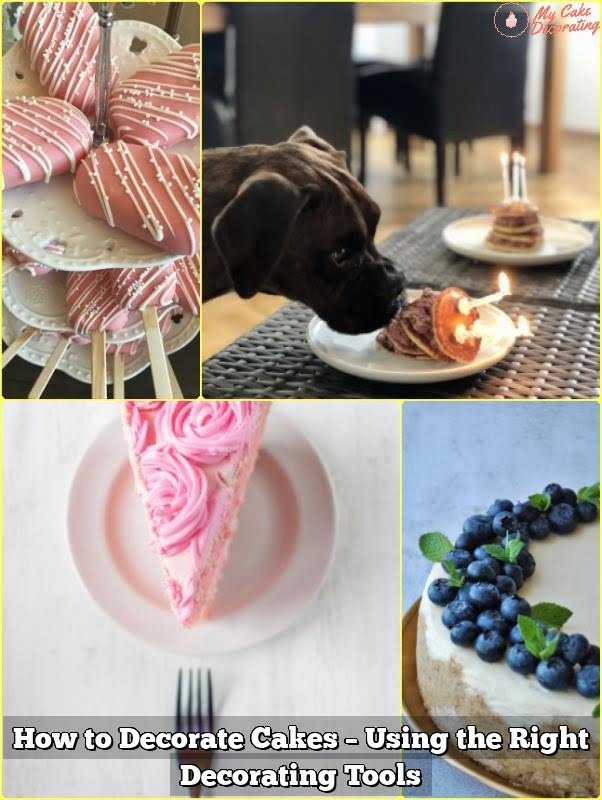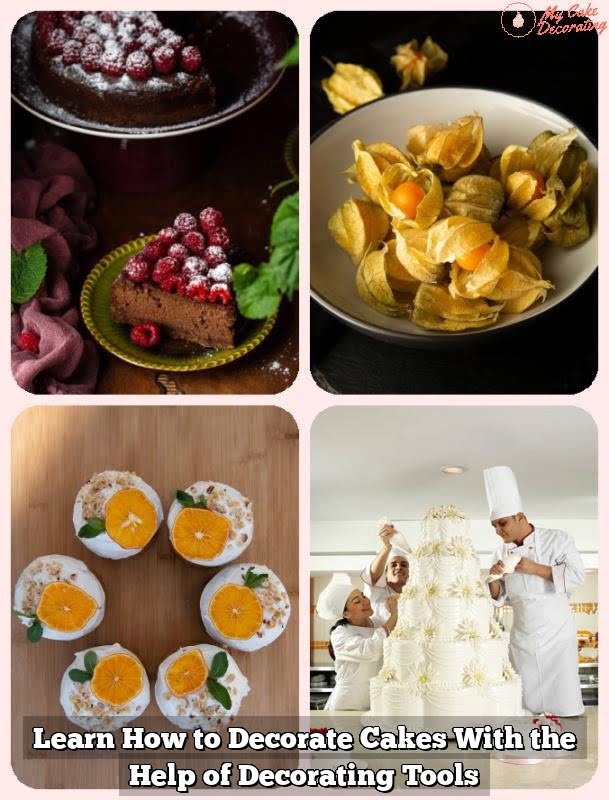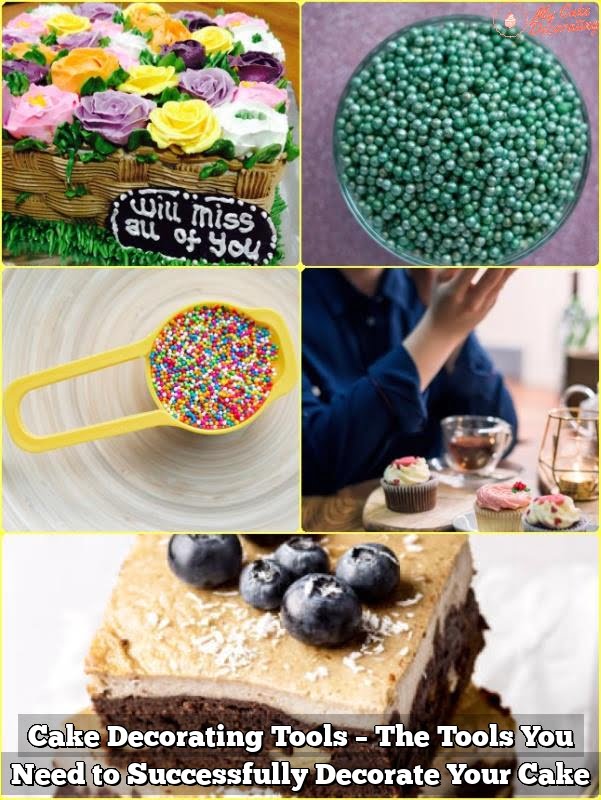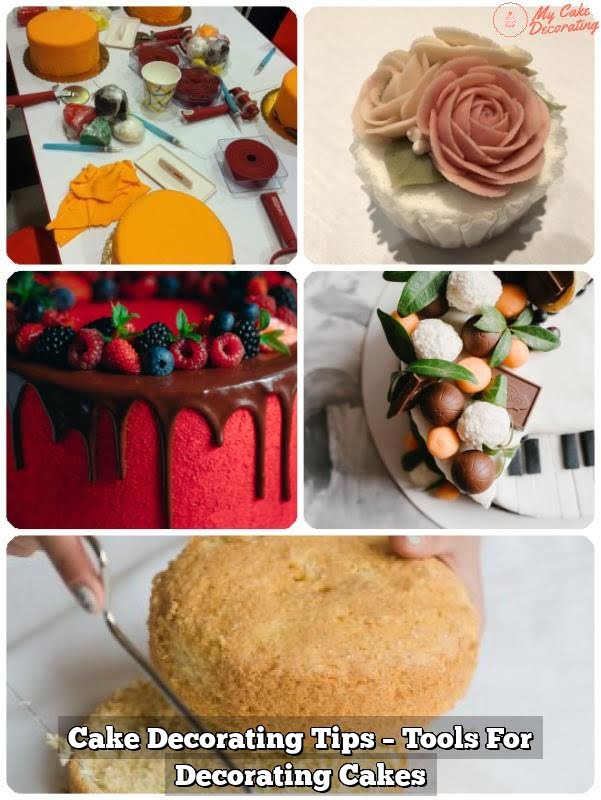Decorating cakes is not just about artistic skill and creativity; it also requires having the right tools at your disposal. In fact, using the appropriate cake decorating tools can make a tremendous difference in the outcome of your cake decoration projects. From ensuring smooth fondant finishes to creating intricate piping designs, these tools are essential for achieving professional-looking results.
Using proper cake decorating tools offers a myriad of benefits. Firstly, they provide precision and control, allowing you to execute even the most intricate designs with ease. Whether you’re looking to create stunning borders or sculpt lifelike cake toppers, having the right tools ensures that you achieve your desired outcome accurately and effortlessly.
Additionally, using the right tools can save you valuable time and effort. Cake decorating involves various techniques that can be time-consuming if not equipped with suitable tools. For example, leveling a cake evenly without proper leveling tools can be challenging and may result in an uneven structure that affects the overall appearance of the finished product.
In this comprehensive guide to cake decorating tools, we will explore a wide range of instruments specifically designed to elevate your cake decoration game. From essential piping tips and bags to intricate modeling tools, we’ll cover everything you need to know about investing in high-quality equipment for professional results.
So whether you’re a seasoned baker or just starting out on your cake decoration journey, keep reading to discover how these specialized tools can transform your creations into stunning works of art.
Essential Piping Tips and Bags for Cake Decorating
Importance of Piping Tips
When it comes to cake decorating, piping is an essential technique that adds beautiful and intricate designs to cakes. The right piping tip can make all the difference in achieving the desired outcome. Piping tips come in various shapes and sizes, each serving a different purpose.
For example, round tips are versatile and can be used for basic outlines or writing on cakes, while star tips create textured patterns and rosettes. Leaf tips are perfect for creating realistic foliage or delicate flower petals. By using the appropriate piping tip, decorators can bring their cake designs to life and add a professional touch.
Types of Piping Bags
In addition to selecting the right piping tip, choosing the correct piping bag is equally important in achieving optimal results. Piping bags come in different materials such as disposable plastic or reusable fabric. Disposable bags offer convenience as they can be easily disposed of after use, while fabric bags are more durable and eco-friendly. Both options have their advantages depending on personal preference and the specific project at hand.
Different types of piping bags also provide different levels of control when it comes to squeezing out icing or frosting onto cakes. Some decorators prefer disposable bags with a rolled edge that allows for precise control when applying pressure, while others may opt for fabric bags with grips that offer a comfortable grip and good handling during long decorating sessions.
Choosing the right piping bag based on its material and design can greatly enhance the overall experience and efficiency of cake decorating.
Tips for Proper Usage
To achieve clean lines and consistent results, decorators should keep certain tips in mind when using piping tips and bags:
- Prepare your icing consistency: Depending on the design you want to create, adjust the consistency of your icing accordingly. A firmer consistency is ideal for intricate details or piped flowers, while a softer consistency is better for covering larger areas or creating smooth finishes.
- Fill the bag properly: To ensure smooth piping, snip the end of the piping bag and fit it with your desired piping tip. Then, twist and hold the open end of the bag tightly to prevent any icing from seeping out while piping. Carefully scoop the icing into the bag, making sure not to overfill it as this can lead to messy handling.
- Practice piping techniques: Before piping directly onto your cake, practice your piping techniques on a separate surface such as parchment paper or a silicone mat. This will allow you to familiarize yourself with different pressure levels and control over the icing flow.
By understanding the importance of using appropriate piping tips and bags, decorators can elevate their cake designs and achieve professional-looking results that are both visually appealing and delicious.
Tools for Creating Beautiful Borders and Edges
When it comes to cake decoration, intricate borders and edges can really elevate the overall design and make it stand out. Thankfully, there are a variety of tools available that can help achieve stunning borders and edges on cakes.
One essential tool for creating beautiful borders is a piping nozzle. Piping nozzles come in various shapes and sizes, allowing decorators to create different patterns and textures. Some popular piping nozzles include round tips for creating simple borders, star tips for textured designs, and leaf tips for delicate foliage-like borders. These nozzles can be used with piping bags to easily apply frosting or buttercream onto the cake.
In addition to piping nozzles, there are also specialized tools designed specifically for creating intricate borders and edges. One such tool is a border mold or press set. These sets typically include various molds or presses that can be used to emboss designs onto the sides of the cake. From lace patterns to geometric shapes, these tools allow decorators to add visually appealing details effortlessly.
Another versatile tool is an edge cutter. Edge cutters come in different sizes and shapes, such as scalloped or serrated edges. They are perfect for achieving clean and precise lines on cake borders. By simply pressing the cutter against the side of the cake, decorators can create interesting textures and designs that instantly enhance the overall appearance.
Using these tools, decorators have endless possibilities when it comes to creating beautiful borders and edges on their cakes. Whether you prefer classic designs or want to experiment with more elaborate patterns, incorporating these tools into your cake decorating arsenal will allow you to take your creations to the next level.
Must-Have Tools for Fondant Decoration
Fondant decoration has become increasingly popular in cake decorating due to its versatility and ability to create a smooth, polished finish. To achieve professional-looking fondant decorations, it is essential to have the right tools at your disposal. Here are some must-have tools for working with fondant:
- Fondant Smoothers: Fondant smoothers are used to create a perfectly smooth surface on the cake. They help to eliminate any wrinkles or air bubbles that may form while rolling out the fondant. There are different types of smoothers available, such as large flat smoothers and small handheld ones, each serving a specific purpose.
- Cutters: Cutters are indispensable tools in fondant decoration as they allow you to create various shapes and designs. They come in different sizes and shapes, including flowers, leaves, letters, and numbers. With cutters, you can easily add intricate details to your cake decorations.
- Embossing Tools: Embossing tools are used to add texture and patterns onto the fondant surface. They come in various designs and allow you to create beautiful imprints on your cake decorations. These tools can be used to make quilted patterns or even mimic fabric textures for a more realistic look.
In addition to these basic tools, there are other accessories that can assist you in working with fondant such as rolling pins specifically designed for fondant, silicone mats for easy rolling and lifting of the fondant, and dusting brushes for applying cornstarch or powdered sugar to prevent sticking.
By investing in these must-have tools for fondant decoration, you can ensure that your cake decorations have a professional finish with smooth edges, intricate details, and realistic textures. Using quality tools also makes the process more enjoyable and efficient as they provide better control over shaping and designing your fondant creations.
Cake Stencils and Airbrushing Tools for Stunning Patterns
Cake stencils and airbrushing tools are essential for creating stunning patterns and designs on cakes. These tools offer decorators a wide range of options to add depth, intricacy, and color to their cake decorations. By using cake stencils and airbrushing tools effectively, decorators can elevate their designs and create professional-looking cakes.
Cake stencils are templates that can be used to transfer intricate patterns onto cakes. They come in various shapes, sizes, and designs, allowing decorators to create elaborate patterns with ease. Stencils can be made from plastic, metal, or even edible materials such as rice paper or fondant. They are placed directly on the cake surface and can be secured with gentle pressure or held in place by icing.
Airbrushing tools are handheld devices that allow decorators to spray a fine mist of edible colors onto the cake surfaces. This technique enables decorators to achieve smooth gradients of color, shading effects, or even create realistic images and textures. Airbrushing is especially useful for creating stunning backgrounds or adding intricate details such as shadowing or highlighting.
Using cake stencils and airbrushing tools requires some practice and skill to achieve the desired results. Decorators should start by selecting the right stencil design that suits their theme or vision for the cake. Careful positioning and securing of the stencil will help ensure clean lines and accurate patterns. When using airbrushing tools, it’s crucial to control the amount of color sprayed onto the cake surface by adjusting the air pressure and distance from the surface.
| Cake Stencils and Airbrushing Tools for Stunning Patterns |
|---|
| – Cake stencils and airbrushing tools are essential for creating stunning patterns and designs on cakes. |
| – Cake stencils allow decorators to transfer intricate patterns onto cakes, while airbrushing tools add depth, shading effects, or realistic images and textures. |
| – Practice and attention to detail are crucial when using these tools to achieve professional-looking cake decorations. |
Tools for Sculpting and Modeling Cake Toppers
Creating unique and customized cake toppers is a popular trend in cake decoration. Whether it’s for a wedding, birthday, or any other special occasion, sculpting and modeling cake toppers can add a personal touch to the design. However, achieving realistic figures and shapes requires the right tools. In this section, we will explore various tools that are commonly used for sculpting and modeling cake toppers out of fondant or gum paste.
Modeling Tools
One of the essential tools for sculpting and modeling cake toppers is a set of modeling tools. These tools come in different shapes and sizes, allowing decorators to shape and mold fondant or gum paste with precision. Modeling tools often have dual-ended designs with different tips such as ball, cone, or blade-shaped ends. These ends help create distinctive features like facial expressions, clothing details, or fabric textures on the cake topper.
Pasta Machines
Pasta machines are not just for making pasta. They can also be incredibly useful in creating smooth sheets of fondant or gum paste for sculpting cake toppers. By rolling out the fondant or gum paste using a pasta machine, decorators can achieve an even thickness which makes it easier to work with when adding intricate details to the figures. It also saves time compared to manually rolling out large pieces of fondant.
Wire Tools
Wire tools are another set of essential tools for sculpting and modeling cake toppers. These thin wires with handles at one end are perfect for creating structural support and adding movement to figures such as arms or legs. Wire loop tools are commonly used for shaping hands or creating hollow areas like eye sockets. Wire cutters are also handy in trimming excess wire length from these structures.
Molds and Impressions
In addition to hand-sculpting techniques, molds and impressions can make the process of creating cake toppers easier and more consistent. There is a wide range of silicone molds available on the market for different shapes and sizes, such as flowers, butterflies, or even faces. These molds allow decorators to create intricate details quickly and efficiently by simply pressing fondant or gum paste into the mold and then releasing it for a perfectly shaped element.
When it comes to sculpting and modeling cake toppers, having the right tools can make all the difference. From modeling tools for shaping features to pasta machines for creating smooth sheets, decorators have an array of options to help bring their vision to life. By investing in these tools, cake decorators can elevate their creations and achieve professional-looking cake toppers that will impress any crowd.
Leveling and Icing Tools for an Even and Polished Finish
Achieving a perfectly level cake is crucial for creating a professional-looking cake decoration. Uneven layers can affect the stability of the cake and make it challenging to apply icing evenly. That’s why leveling tools are essential for every decorator. There are several options available, including cake levelers, serrated knives, and even dental floss.
A cake leveler is a must-have tool that allows decorators to trim the top of each cake layer to ensure they are all the same height. This tool typically consists of a wire attached to two handles that can be adjusted to the desired height. By sliding the wire across the cake, decorators can easily remove any excess or uneven portions.
Another popular leveling tool is a serrated knife. Many decorators prefer using this traditional kitchen tool because it provides more control over the leveling process. Simply hold the blade parallel to the countertop and carefully slice off any uneven areas until the desired level is achieved.
For those looking for an alternative method, dental floss can surprisingly be used as an effective leveling tool. It works particularly well with softer cakes like sponge or chiffon. By holding each end of a long piece of dental floss tautly and pulling it through the center of the cake, decorators can precisely trim off any domed tops.
Once the cake layers are leveled, it’s time to achieve that smooth and flawless finish with icing tools. The main tool for this task is an icing spatula, also known as a palette knife or offset spatula. This thin, flat-bladed tool features a long handle that allows decorators to spread icing smoothly over cakes without their hands interfering with their work.
In addition to an icing spatula, other tools that can assist in achieving an even and polished finish include bench scrapers and turntables. A bench scraper is a metal or plastic rectangular piece with a straight edge that helps to smooth the sides and tops of cakes. Turntables, on the other hand, are rotating platforms that make it easier to access all angles of the cake while applying icing.
By using these leveling and icing tools, decorators can ensure that their cakes have an even surface and a polished finish. These tools not only enhance the appearance of the cake but also make it easier to achieve professional-looking results. With a leveled and well-iced cake, decorators can move on to adding the finishing touches with other decorative tools for stunning results.
| Leveling Tools | Icing Tools |
|---|---|
| Cake leveler | Icing spatula |
| Serrated knife | Bench scraper |
| Dental floss | Turntable |
Decorating Tools for Adding Detail and Texture
When it comes to cake decoration, adding intricate details and texture can take a cake from ordinary to extraordinary. Fortunately, there are a variety of tools available that allow decorators to achieve this level of artistry. These tools not only help create visually stunning designs but also add depth and personality to the overall cake.
One tool that is essential for adding detail is the decorating pen or fine-tip brush. These tools are perfect for creating delicate lines, writing messages, or drawing intricate designs on cakes. Whether you want to add personalized messages or create elaborate floral patterns, having a decorating pen or fine-tip brush in your toolkit will enable you to bring your vision to life.
Texture is another important element in cake decoration, as it adds visual interest and dimension. One popular tool for adding texture is the textured rolling pin. These rolling pins have various patterns engraved on them, such as lace, flowers, or geometric shapes. By gently rolling the pin over fondant or gum paste, you can transfer these patterns onto the surface of the cake for a beautiful and unique textured effect.
Another tool that decorators can utilize to add texture is the impression mat. These flexible mats have different textures imprinted on one side, such as brick walls, quilted patterns, or wood grains. By pressing the mat onto fondant or gum paste before applying it to the cake, decorators can create lifelike textures and designs that mimic various materials.
In addition to pens and brushes for detail work and textured tools like rolling pins and impression mats, there are various other tools available that can be used to add even more visual interest and complexity to your cakes. For example, silicone molds with intricate designs allow decorators to easily create decorative elements such as flowers or leaves out of fondant or gum paste. Edible embellishments like pearls or dragees can also be added using specialized tweezers.
By incorporating these decorating tools into your cake projects, you can elevate the overall design, create stunning visual effects, and wow your guests with professional-level cake decorations. Experiment with different tools and techniques to discover your own unique style and unleash your creativity in the world of cake decoration.
Conclusion
In conclusion, it is clear that using the right tools for cake decoration is crucial in achieving professional results. Throughout this article, we have explored various tools that can elevate the overall design of cakes and make a significant difference in the outcome of decorating projects.
From essential piping tips and bags to tools for creating beautiful borders and edges, each tool serves a specific purpose in enhancing the visual appeal of cakes. The importance and functionality of different piping tips have been explained, along with the various types of piping bags available and their uses. Additionally, we have discussed how specific tools can be used to create intricate borders and edges on cakes, showcasing different techniques that elevate the design.
We also explored must-have tools for fondant decoration, such as fondant smoothers, cutters, and embossing tools. These tools are essential in achieving smooth and professional-looking fondant decorations. Furthermore, cake stencils and airbrushing tools were highlighted as key elements in creating stunning patterns and designs on cakes.
Sculpting and modeling cake toppers require specialized tools made from fondant or gum paste. These tools allow decorators to create realistic figures and shapes with precision. Leveling and icing tools are vital for achieving an even and polished finish on cakes, ensuring a smooth surface for further decoration.
Lastly, various decorating tools enable decorators to add intricate details and texture to their cakes. These tools bring cakes to life by enhancing their overall design. Therefore, investing in high-quality cake decorating tools is essential for professionals who strive for exceptional results in their projects.
Frequently Asked Questions
What tools to decorate cake?
There are various tools that can be used to decorate a cake, depending on the desired design and technique. One common tool is the piping bag, which allows for precise and controlled application of frosting or icing onto the cake. Different types of piping tips can also be used with the piping bag to create different designs such as rosettes, stars, or writing.
Another common tool is the offset spatula, which is useful for smoothly spreading frosting over the surface of the cake or creating textured patterns. Fondant smoothers are helpful for achieving a smooth finish when working with fondant, while a turntable allows for easy rotating of the cake during decorating to ensure even coverage.
What is the thing used to decorate cakes called?
The term used to describe the thing specifically used to decorate cakes is typically referred to as a “decorating tool” or simply a “cake decorating tool.” This encompasses various instruments and utensils that are utilized in enhancing the appearance of a cake through techniques like frosting, piping, molding fondant, or adding intricate designs.
What are the tools used in decorating a cake give at least 10 tools?
There is a wide range of tools that can be employed in cake decorating, offering versatility in design and execution. Here are ten examples of such tools:

Welcome to my blog about home and family. This blog is a place where I will share my thoughts, ideas, and experiences related to these important topics. I am a stay-at-home mom with two young children. I hope you enjoy reading it! and may find some helpful tips and ideas that will make your home and family life even better!





